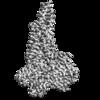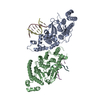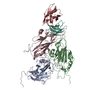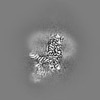[English] 日本語
 Yorodumi
Yorodumi- EMDB-30590: Cryo-EM structure of the human glucagon-like peptide-2 receptor-G... -
+ Open data
Open data
- Basic information
Basic information
| Entry | Database: EMDB / ID: EMD-30590 | |||||||||
|---|---|---|---|---|---|---|---|---|---|---|
| Title | Cryo-EM structure of the human glucagon-like peptide-2 receptor-Gs protein complex | |||||||||
 Map data Map data | ||||||||||
 Sample Sample |
| |||||||||
 Keywords Keywords | Glucagon-like peptide-2 receptor / Drug target / Class B GPCR / BIOSYNTHETIC PROTEIN | |||||||||
| Function / homology |  Function and homology information Function and homology informationglucagon receptor binding / Olfactory Signaling Pathway / Sensory perception of sweet, bitter, and umami (glutamate) taste / Synthesis, secretion, and inactivation of Glucagon-like Peptide-1 (GLP-1) / glucagon receptor activity / sensory perception of chemical stimulus / protein kinase A signaling / mu-type opioid receptor binding / Activation of the phototransduction cascade / corticotropin-releasing hormone receptor 1 binding ...glucagon receptor binding / Olfactory Signaling Pathway / Sensory perception of sweet, bitter, and umami (glutamate) taste / Synthesis, secretion, and inactivation of Glucagon-like Peptide-1 (GLP-1) / glucagon receptor activity / sensory perception of chemical stimulus / protein kinase A signaling / mu-type opioid receptor binding / Activation of the phototransduction cascade / corticotropin-releasing hormone receptor 1 binding / negative regulation of execution phase of apoptosis / feeding behavior / beta-2 adrenergic receptor binding / Activation of G protein gated Potassium channels / G-protein activation / G beta:gamma signalling through PI3Kgamma / Prostacyclin signalling through prostacyclin receptor / G beta:gamma signalling through PLC beta / ADP signalling through P2Y purinoceptor 1 / Thromboxane signalling through TP receptor / Presynaptic function of Kainate receptors / G beta:gamma signalling through CDC42 / Inhibition of voltage gated Ca2+ channels via Gbeta/gamma subunits / G alpha (12/13) signalling events / Glucagon-type ligand receptors / G beta:gamma signalling through BTK / ADP signalling through P2Y purinoceptor 12 / Adrenaline,noradrenaline inhibits insulin secretion / Cooperation of PDCL (PhLP1) and TRiC/CCT in G-protein beta folding / Ca2+ pathway / Thrombin signalling through proteinase activated receptors (PARs) / G alpha (z) signalling events / Extra-nuclear estrogen signaling / G alpha (s) signalling events / G alpha (q) signalling events / G alpha (i) signalling events / Glucagon-like Peptide-1 (GLP1) regulates insulin secretion / High laminar flow shear stress activates signaling by PIEZO1 and PECAM1:CDH5:KDR in endothelial cells / Vasopressin regulates renal water homeostasis via Aquaporins / positive regulation of calcium ion import / peptide hormone binding / Synthesis, secretion, and deacylation of Ghrelin / D1 dopamine receptor binding / positive regulation of insulin secretion involved in cellular response to glucose stimulus / adenylate cyclase-activating adrenergic receptor signaling pathway / insulin-like growth factor receptor binding / positive regulation of gluconeogenesis / ionotropic glutamate receptor binding / cellular response to glucagon stimulus / regulation of insulin secretion / adenylate cyclase activator activity / response to activity / gluconeogenesis / G protein-coupled receptor activity / hormone activity / adenylate cyclase-modulating G protein-coupled receptor signaling pathway / G-protein beta/gamma-subunit complex binding / adenylate cyclase-activating G protein-coupled receptor signaling pathway / Glucagon signaling in metabolic regulation / Synthesis, secretion, and inactivation of Glucagon-like Peptide-1 (GLP-1) / photoreceptor disc membrane / Glucagon-type ligand receptors / Glucagon-like Peptide-1 (GLP1) regulates insulin secretion / cellular response to catecholamine stimulus / adenylate cyclase-activating dopamine receptor signaling pathway / cellular response to prostaglandin E stimulus / glucose homeostasis / G-protein beta-subunit binding / heterotrimeric G-protein complex / sensory perception of taste / signaling receptor complex adaptor activity / retina development in camera-type eye / GTPase binding / secretory granule lumen / G alpha (s) signalling events / phospholipase C-activating G protein-coupled receptor signaling pathway / Hydrolases; Acting on acid anhydrides; Acting on GTP to facilitate cellular and subcellular movement / G alpha (q) signalling events / cell surface receptor signaling pathway / cell population proliferation / positive regulation of ERK1 and ERK2 cascade / G protein-coupled receptor signaling pathway / receptor ligand activity / endoplasmic reticulum lumen / signaling receptor binding / GTPase activity / positive regulation of cell population proliferation / synapse / negative regulation of apoptotic process / protein-containing complex binding / GTP binding / extracellular space / extracellular region / metal ion binding / identical protein binding / membrane / plasma membrane / cytoplasm Similarity search - Function | |||||||||
| Biological species |   Homo sapiens (human) Homo sapiens (human) | |||||||||
| Method | single particle reconstruction / cryo EM / Resolution: 3.0 Å | |||||||||
 Authors Authors | Sun W / Chen L | |||||||||
 Citation Citation |  Journal: Cell Res / Year: 2020 Journal: Cell Res / Year: 2020Title: A unique hormonal recognition feature of the human glucagon-like peptide-2 receptor. Authors: Wen Sun / Li-Nan Chen / Qingtong Zhou / Li-Hua Zhao / Dehua Yang / Huibing Zhang / Zhaotong Cong / Dan-Dan Shen / Fenghui Zhao / Fulai Zhou / Xiaoqing Cai / Yan Chen / Yan Zhou / Sarina ...Authors: Wen Sun / Li-Nan Chen / Qingtong Zhou / Li-Hua Zhao / Dehua Yang / Huibing Zhang / Zhaotong Cong / Dan-Dan Shen / Fenghui Zhao / Fulai Zhou / Xiaoqing Cai / Yan Chen / Yan Zhou / Sarina Gadgaard / Wijnand J C van der Velden / Suwen Zhao / Yi Jiang / Mette M Rosenkilde / H Eric Xu / Yan Zhang / Ming-Wei Wang /   Abstract: Glucagon-like peptides (GLP-1 and GLP-2) are two proglucagon-derived intestinal hormones that mediate distinct physiological functions through two related receptors (GLP-1R and GLP-2R) which are ...Glucagon-like peptides (GLP-1 and GLP-2) are two proglucagon-derived intestinal hormones that mediate distinct physiological functions through two related receptors (GLP-1R and GLP-2R) which are important drug targets for metabolic disorders and Crohn's disease, respectively. Despite great progress in GLP-1R structure determination, our understanding on the differences of peptide binding and signal transduction between these two receptors remains elusive. Here we report the electron microscopy structure of the human GLP-2R in complex with GLP-2 and a G heterotrimer. To accommodate GLP-2 rather than GLP-1, GLP-2R fine-tunes the conformations of the extracellular parts of transmembrane helices (TMs) 1, 5, 7 and extracellular loop 1 (ECL1). In contrast to GLP-1, the N-terminal histidine of GLP-2 penetrates into the receptor core with a unique orientation. The middle region of GLP-2 engages with TM1 and TM7 more extensively than with ECL2, and the GLP-2 C-terminus closely attaches to ECL1, which is the most protruded among 9 class B G protein-coupled receptors (GPCRs). Functional studies revealed that the above three segments of GLP-2 are essential for GLP-2 recognition and receptor activation, especially the middle region. These results provide new insights into the molecular basis of ligand specificity in class B GPCRs and may facilitate the development of more specific therapeutics. | |||||||||
| History |
|
- Structure visualization
Structure visualization
| Movie |
 Movie viewer Movie viewer |
|---|---|
| Structure viewer | EM map:  SurfView SurfView Molmil Molmil Jmol/JSmol Jmol/JSmol |
| Supplemental images |
- Downloads & links
Downloads & links
-EMDB archive
| Map data |  emd_30590.map.gz emd_30590.map.gz | 28.5 MB |  EMDB map data format EMDB map data format | |
|---|---|---|---|---|
| Header (meta data) |  emd-30590-v30.xml emd-30590-v30.xml emd-30590.xml emd-30590.xml | 20 KB 20 KB | Display Display |  EMDB header EMDB header |
| Images |  emd_30590.png emd_30590.png | 64.2 KB | ||
| Filedesc metadata |  emd-30590.cif.gz emd-30590.cif.gz | 7 KB | ||
| Archive directory |  http://ftp.pdbj.org/pub/emdb/structures/EMD-30590 http://ftp.pdbj.org/pub/emdb/structures/EMD-30590 ftp://ftp.pdbj.org/pub/emdb/structures/EMD-30590 ftp://ftp.pdbj.org/pub/emdb/structures/EMD-30590 | HTTPS FTP |
-Validation report
| Summary document |  emd_30590_validation.pdf.gz emd_30590_validation.pdf.gz | 409.4 KB | Display |  EMDB validaton report EMDB validaton report |
|---|---|---|---|---|
| Full document |  emd_30590_full_validation.pdf.gz emd_30590_full_validation.pdf.gz | 409 KB | Display | |
| Data in XML |  emd_30590_validation.xml.gz emd_30590_validation.xml.gz | 5.9 KB | Display | |
| Data in CIF |  emd_30590_validation.cif.gz emd_30590_validation.cif.gz | 6.8 KB | Display | |
| Arichive directory |  https://ftp.pdbj.org/pub/emdb/validation_reports/EMD-30590 https://ftp.pdbj.org/pub/emdb/validation_reports/EMD-30590 ftp://ftp.pdbj.org/pub/emdb/validation_reports/EMD-30590 ftp://ftp.pdbj.org/pub/emdb/validation_reports/EMD-30590 | HTTPS FTP |
-Related structure data
| Related structure data |  7d68MC M: atomic model generated by this map C: citing same article ( |
|---|---|
| Similar structure data |
- Links
Links
| EMDB pages |  EMDB (EBI/PDBe) / EMDB (EBI/PDBe) /  EMDataResource EMDataResource |
|---|---|
| Related items in Molecule of the Month |
- Map
Map
| File |  Download / File: emd_30590.map.gz / Format: CCP4 / Size: 42.9 MB / Type: IMAGE STORED AS FLOATING POINT NUMBER (4 BYTES) Download / File: emd_30590.map.gz / Format: CCP4 / Size: 42.9 MB / Type: IMAGE STORED AS FLOATING POINT NUMBER (4 BYTES) | ||||||||||||||||||||||||||||||||||||||||||||||||||||||||||||||||||||
|---|---|---|---|---|---|---|---|---|---|---|---|---|---|---|---|---|---|---|---|---|---|---|---|---|---|---|---|---|---|---|---|---|---|---|---|---|---|---|---|---|---|---|---|---|---|---|---|---|---|---|---|---|---|---|---|---|---|---|---|---|---|---|---|---|---|---|---|---|---|
| Projections & slices | Image control
Images are generated by Spider. | ||||||||||||||||||||||||||||||||||||||||||||||||||||||||||||||||||||
| Voxel size | X=Y=Z: 1.014 Å | ||||||||||||||||||||||||||||||||||||||||||||||||||||||||||||||||||||
| Density |
| ||||||||||||||||||||||||||||||||||||||||||||||||||||||||||||||||||||
| Symmetry | Space group: 1 | ||||||||||||||||||||||||||||||||||||||||||||||||||||||||||||||||||||
| Details | EMDB XML:
CCP4 map header:
| ||||||||||||||||||||||||||||||||||||||||||||||||||||||||||||||||||||
-Supplemental data
- Sample components
Sample components
+Entire : Cryo-EM structure of the human glucagon-like peptide-2 receptor-G...
+Supramolecule #1: Cryo-EM structure of the human glucagon-like peptide-2 receptor-G...
+Supramolecule #2: Guanine nucleotide-binding protein
+Supramolecule #3: Nanobody-35
+Supramolecule #4: Glucagon-like peptide 2 receptor
+Macromolecule #1: Guanine nucleotide-binding protein G(s) subunit alpha isoforms short
+Macromolecule #2: Guanine nucleotide-binding protein G(I)/G(S)/G(T) subunit beta-1
+Macromolecule #3: Guanine nucleotide-binding protein G(I)/G(S)/G(O) subunit gamma-2
+Macromolecule #4: Nanobody-35
+Macromolecule #5: Pro-glucagon
+Macromolecule #6: Glucagon-like peptide 2 receptor
+Macromolecule #7: water
-Experimental details
-Structure determination
| Method | cryo EM |
|---|---|
 Processing Processing | single particle reconstruction |
| Aggregation state | particle |
- Sample preparation
Sample preparation
| Buffer | pH: 7.4 |
|---|---|
| Vitrification | Cryogen name: ETHANE |
- Electron microscopy
Electron microscopy
| Microscope | FEI TITAN KRIOS |
|---|---|
| Image recording | Film or detector model: GATAN K2 QUANTUM (4k x 4k) / Detector mode: COUNTING / Average electron dose: 64.0 e/Å2 |
| Electron beam | Acceleration voltage: 300 kV / Electron source:  FIELD EMISSION GUN FIELD EMISSION GUN |
| Electron optics | Illumination mode: FLOOD BEAM / Imaging mode: BRIGHT FIELD |
| Experimental equipment |  Model: Titan Krios / Image courtesy: FEI Company |
 Movie
Movie Controller
Controller




























 Z (Sec.)
Z (Sec.) Y (Row.)
Y (Row.) X (Col.)
X (Col.)
























